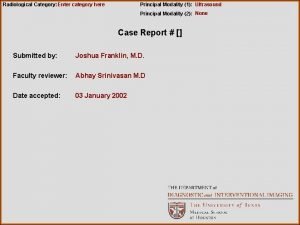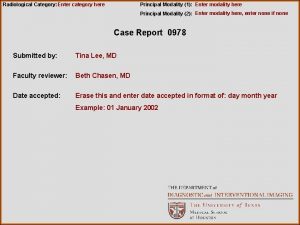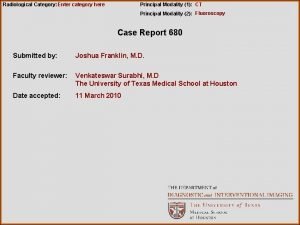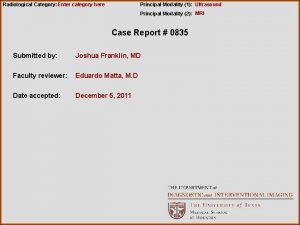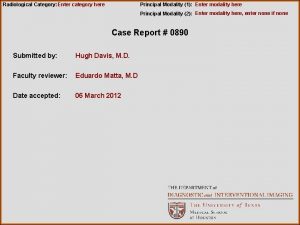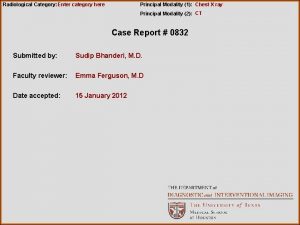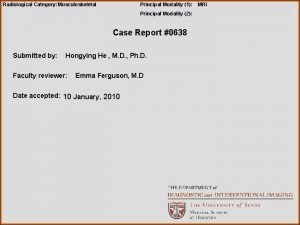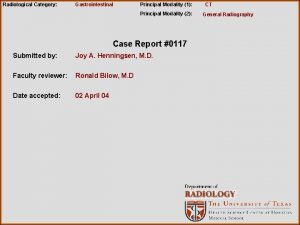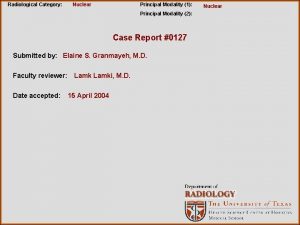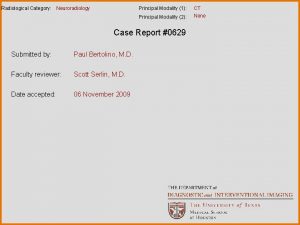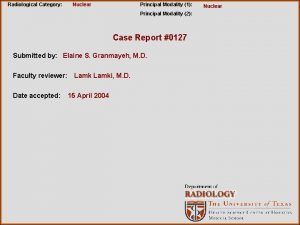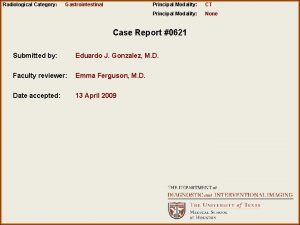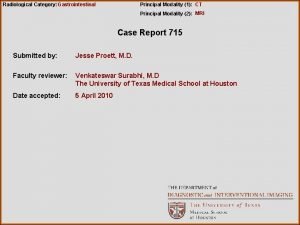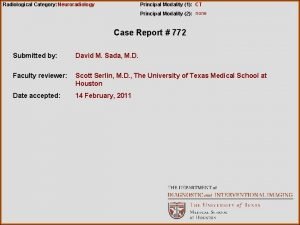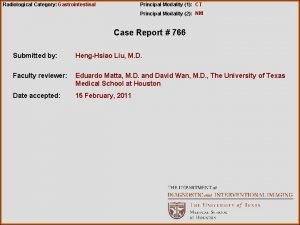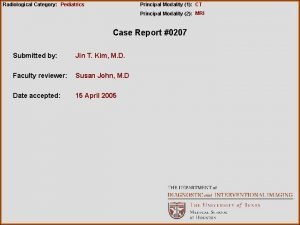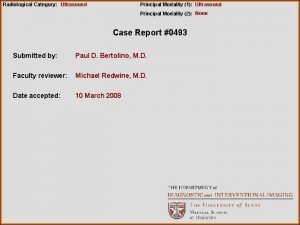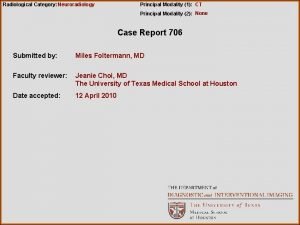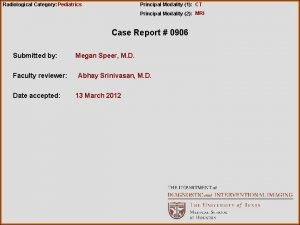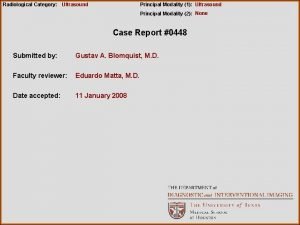Radiological Category Enter category here Principal Modality 1
























- Slides: 24

Radiological Category: Enter category here Principal Modality (1): Ultrasound Principal Modality (2): Radiograph Case Report # 810 Submitted by: Sarah Cantrell, M. D. Faculty reviewer: Abhay Srinivasan, M. D. The University of Texas Medical School at Houston Date accepted: 15 April, 2011

Case History 17 day old transferred from outside facility with high output heart failure, elevated BNP and history of liver lesion discovered on prenatal ultrasound

Radiological Presentations Grayscale of the liver performed at Memorial Hermann

Radiological Presentations Grayscale of the liver performed at Memorial Hermann

Radiological Presentations Color Doppler of the liver performed at Memorial Hermann

Radiological Presentations Color Doppler of the liver performed at Memorial Hermann

Radiological Presentations Chest radiograph obtained at age 4 weeks

Test Your Diagnosis Which one of the following is your choice for the appropriate diagnosis? After your selection, go to next page. • Hemangioendothelioma • Hepatoblastoma • Hepatocellular carcinoma • Mesenchymal hemartoma • Metastases

Findings and Differentials Findings: Proceed to next slide for findings Differentials: • Hemangioendothelioma • Hepatoblastoma • Hepatocellular carcinoma • Mesenchymal hemartoma • Metastases

Findings Grayscale images demonstrate a well circumscribed mass with multiple hypoechoic foci within the posterior right lobe of the liver measuring 5. 4 cm x 4. 2 cm x 4. 6 cm.

Findings A B Grayscale of the liver performed at Memorial Hermann demonstrate dilatation of the hepatic veins (A) and inferior vena cava (B)

Findings ← Color Doppler demonstrates increased vascularity surrounding the liver lesion and within the lesion with high flow, evidenced by aliasing (arrow), in the region of the proper hepatic artery. High flow is noted predominantly within the periphery of the lesion. There is absence of flow within the center of the lesion consistent with thrombosed vasculature

Findings ← Color Doppler demonstrates increased vascularity surrounding the liver lesion and within the lesion with high flow feeder artery, (arrow) evidenced by aliasing, in the region of the proper hepatic artery

Findings Portable chest radiograph demonstrates cardiomegaly with increased pulmonary vascular markings consistent with high output heart failure

Discussion • Evaluation of pediatric liver masses: – Ultrasonography is the initial examination of choice in order to confirm the presence of a hepatic mass and characterize the mass. – MRI and CT may be helpful in confirming the initial ultrasound exam findings and demonstrating the extent and resectability of hepatic masses.

Discussion Hemangioendothelioma • Definition: – Benign endothelial lined vascular mass – Type I- variable-seized vascular channels lined by plump endothelial cells supported by reticular fibers – Type II- irregular branching channels lined by immature, pleomorphic cells which demonstrate potential for rare malignant transformation • Epidemiology: 1/3 of all pediatric hepatic tumors and most common benign hepatic tumor of childhood • Clinical presentation is variable and hemangioendothelioma may present with any of the following: – Asymptomatic mass – High output heart failure due to high output overcirculation – Hepatic mass with consumptive coagulopathy secondary to platelet sequestration (Kasabach-Merritt syndrome) • Natural History and Prognosis: – Most involute over time, requiring no intervention and may be followed with sequential ultrasound

Discussion Hemangioendothelioma Sonographic Features: • Grayscale images – Complex mostly solid mass – Predominantly hypoechoic but may have mixed echogenicity if hemorrhage or thrombus is present – Calcifications are common and demonstrate “coarse” or “fine” morphology • Color Doppler – prominent high flow vascular structures • Shunting toward the lesion may result in dilatation of the aorta proximal to the celiac axis with decreased caliber of the infrahepatic aorta

Discussion Hemangioendothelioma Imaging Features • MRI: – T 1 WI: • High signal intensity relative to normal liver and spleen parenchyma • Increased signal intensity within areas of hemorrhage • – T 2 WI: • High signal intensity relative to normal liver and spleen parenchyma • Prominent flow voids around the lesion from surrounding feeding and draining vessels • Conventional angiography – Vascular mass with AV shunting – Dilated tortuous hepatic artery – Dilatation of draining hepatic veins with early filling – Abnormal pooling of contrast in focal areas

Discussion Hepatoblastoma • children <5 years of age • 50% occur in children <1 year of age • associated with Beckwith-Wiedemann syndrome, isosexual precocity and fetal alcohol syndrome • composed of small primitive epithelial cells resembling fetal liver or embryonal cells • alpha fetal protein elevated in 60 -70% Hepatocellular carcinoma • children >3 years of age • often occur in the setting of chronic liver diseases including type I glycogen storage disease, cystinosis, tyrosinemia, Wilson’s disease and alpha-1 antitrypsin deficiency • composed of large, pleomorphic, multinucleated cells with various degrees of differentiation • alpha fetal protein elevated in 50%

Discussion Hepatoblastoma and Hepatocellular Carcinoma • Grayscale images – Most commonly poorly marginated masses that are hypoechoic to isoechoic relative to surrounding liver tissue. – Tumor may have hypoechoic rim, distort and invade surrounding vascular structures and demonstrate “chunky” tumoral calcifications. – Vascular invasion is demonstrated as an echogenic intraluminal filling defects. • Color Doppler – demonstrates “basket pattern” of peritumoral flow composed of fine network of blood vessels surrounding the tumor nodule.

Discussion Mesenchymal Hemartoma • Encapsulated mass composed of multiple cystic spaces containing mucoid or gelatinous material separated by a fibrous stroma • Epidemiology – second most common benign hepatic tumor in childhood – Children <2 years Sonographic Features • Anechoic cystic spaces divided by echogenic septa • May demonstrate prominent solid components with small cystic compartments giving “swiss cheese” appearance • Calcifications rare

Discussion

Diagnosis Findings consistent with hemangioendothelioma with high flow enlarged feeding hepatic artery

References Chung EM, Regino, C, Lewis, RB, Conran M. From the Archives of the AFIP: Pediatric Liver Masses: Radiologic-Pathologic Correlation Part 1. Benign Tumors Radiographics May 2010 30: 801 -826. Chung M, EM, Lattin, GE, Regino, C, Lewis, RB, Marichal-Hernandez C, Shawhan R, Conran M. From the Archives of AFIP Pediatric Liver Masses: Radiologic-Pathologic Correlation Part 2. Malignant Tumors. Radio. Graphics 2011; 31: 483– 507. Donnelly LF, Fundamentals of Pediatric Radiology. Philadelphia: WB Saunders 2001. Keslar PJ, Buck JL, Selby DM. From the archives of the AFIP. Infantile hemangioendothelioma of the liver revisited. Radiographic. 1993. Roos JE, Pfiffner R, Stallmach T, Stuckmann G, Marincek B, Willi U. Infantile Hemangioendothelioma. Radiographics 1993; 13: 657 -670. Siegel M, Pediatric Sonography Third Edition. Philadelphia: Lippincott Williams and Wilkins
 Tennessee division of radiological health
Tennessee division of radiological health Center for devices and radiological health
Center for devices and radiological health National radiological emergency preparedness conference
National radiological emergency preparedness conference Radiological dispersal device
Radiological dispersal device Type your title here
Type your title here Considered as a border between upper hell and lower hell.
Considered as a border between upper hell and lower hell. Let no man ignorant of geometry enter here
Let no man ignorant of geometry enter here Erate category 2 eligible equipment
Erate category 2 eligible equipment There's a place where mercy reigns and never dies
There's a place where mercy reigns and never dies Cardinality and modality
Cardinality and modality Modality erd
Modality erd Entity class in software engineering
Entity class in software engineering Epistemic modality
Epistemic modality Birads score
Birads score Data modeling fundamentals
Data modeling fundamentals Modality in statistics
Modality in statistics Modality
Modality Modality in software engineering
Modality in software engineering Deontic and epistemic modality exercises
Deontic and epistemic modality exercises Modality in software engineering
Modality in software engineering Characteristics of sensory neurons
Characteristics of sensory neurons Modality
Modality Skill focus: persuasion
Skill focus: persuasion Pacs modality workstation
Pacs modality workstation Monode electrode
Monode electrode

























